Angina and Non-Obstructive Coronary Artery (ANOCA) Patients with Coronary Vasomotor Disorders
Abstract
:1. Introduction
2. Materials and Methods
2.1. Patient Enrolment
Inclusion and Exclusion Criteria
2.2. Outcome Data Collection
2.3. Data Analysis
3. Results
3.1. ANOCA Cohort Overview
3.2. Coronary Vasomotor Disorder Breakdown
3.3. Clinical Characteristics, Risk Factors, and Management
3.4. Three-Year Outcomes
4. Discussion
4.1. Prevalence
4.2. Diagnosis
4.3. Clinical Risk Factors
4.4. Three-Year Outcomes
5. Limitations
6. Conclusions
Author Contributions
Funding
Institutional Review Board Statement
Informed Consent Statement
Data Availability Statement
Conflicts of Interest
References
- Patel, M.R.; Peterson, E.D.; Dai, D.; Brennan, J.M.; Redberg, R.F.; Anderson, H.V.; Brindis, R.G.; Douglas, P.S. Low diagnostic yield of elective coronary angiography. N. Engl. J. Med. 2010, 362, 886–895. [Google Scholar] [CrossRef] [PubMed]
- Tseng, L.Y.; Goc, N.; Schwann, A.N.; Cherlin, E.J.; Kunnirickal, S.J.; Odanovic, N.; Curry, L.A.; Shah, S.M.; Spatz, E.S. Illness Perception and the Impact of a Definitive Diagnosis on Women with Ischemia and No Obstructive Coronary Artery Disease: A Qualitative Study. Circ. Cardiovasc. Qual. Outcomes 2023, 16, 521–529. [Google Scholar] [CrossRef]
- Beltrame, J.F.; Crea, F.; Kaski, J.C.; Ogawa, H.; Ong, P.; Sechtem, U.; Shimokawa, H.; Bairey Merz, C.N.; Coronary Vasomotion Disorders International Study Group. The Who, What, Why, When, How and Where of Vasospastic Angina. Circ. J. 2016, 80, 289–298. [Google Scholar] [CrossRef] [PubMed]
- Ong, P.; Camici, P.G.; Beltrame, J.F.; Crea, F.; Shimokawa, H.; Sechtem, U.; Kaski, J.C.; Bairey Merz, C.N.; Coronary Vasomotion Disorders International Study Group. International standardization of diagnostic criteria for microvascular angina. Int. J. Cardiol. 2018, 250, 16–20. [Google Scholar] [CrossRef] [PubMed]
- Ford, T.J.; Stanley, B.; Good, R.; Rocchiccioli, P.; McEntegart, M.; Watkins, S.; Eteiba, H.; Shaukat, A.; Lindsay, M.; Robertson, K.; et al. Stratified Medical Therapy Using Invasive Coronary Function Testing in Angina: The CorMicA Trial. J. Am. Coll. Cardiol. 2018, 72, 2841–2855. [Google Scholar] [CrossRef]
- Ford, T.J.; Stanley, B.; Sidik, N.; Good, R.; Rocchiccioli, P.; McEntegart, M.; Watkins, S.; Eteiba, H.; Shaukat, A.; Lindsay, M.; et al. 1-Year Outcomes of Angina Management Guided by Invasive Coronary Function Testing (CorMicA). JACC Cardiovasc. Interv. 2020, 13, 33–45. [Google Scholar] [CrossRef]
- Knuuti, J.; Wijns, W.; Saraste, A.; Capodanno, D.; Barbato, E.; Funck-Brentano, C.; Prescott, E.; Storey, R.F.; Deaton, C.; Cuisset, T.; et al. 2019 ESC Guidelines for the diagnosis and management of chronic coronary syndromes. Eur. Heart J. 2020, 41, 407–477. [Google Scholar] [CrossRef]
- Gulati, M.; Levy, P.D.; Mukherjee, D.; Amsterdam, E.; Bhatt, D.L.; Birtcher, K.K.; Blankstein, R.; Boyd, J.; Bullock-Palmer, R.P.; Conejo, T.; et al. 2021 AHA/ACC/ASE/CHEST/SAEM/SCCT/SCMR Guideline for the Evaluation and Diagnosis of Chest Pain: A Report of the American College of Cardiology/American Heart Association Joint Committee on Clinical Practice Guidelines. Circulation 2021, 144, e368–e454. [Google Scholar] [CrossRef]
- Lee, B.K.; Lim, H.S.; Fearon, W.F.; Yong, A.S.; Yamada, R.; Tanaka, S.; Lee, D.P.; Yeung, A.C.; Tremmel, J.A. Invasive evaluation of patients with angina in the absence of obstructive coronary artery disease. Circulation 2015, 131, 1054–1060. [Google Scholar] [CrossRef]
- Jespersen, L.; Hvelplund, A.; Abildstrom, S.Z.; Pedersen, F.; Galatius, S.; Madsen, J.K.; Jorgensen, E.; Kelbaek, H.; Prescott, E. Stable angina pectoris with no obstructive coronary artery disease is associated with increased risks of major adverse cardiovascular events. Eur. Heart J. 2012, 33, 734–744. [Google Scholar] [CrossRef]
- Tavella, R.; Cutri, N.; Tucker, G.; Adams, R.; Spertus, J.; Beltrame, J.F. Natural history of patients with insignificant coronary artery disease. Eur. Heart J. Qual. Care Clin. Outcomes 2016, 2, 117–124. [Google Scholar] [CrossRef] [PubMed]
- MacAlpin, R.N. Cardiac arrest and sudden unexpected death in variant angina: Complications of coronary spasm that can occur in the absence of severe organic coronary stenosis. Am. Heart J. 1993, 125, 1011–1017. [Google Scholar] [CrossRef] [PubMed]
- Togashi, I.; Sato, T.; Soejima, K.; Takatsuki, S.; Miyoshi, S.; Fukumoto, K.; Nishiyama, N.; Suzuki, M.; Hori, S.; Ogawa, S.; et al. Sudden cardiac arrest and syncope triggered by coronary spasm. Int. J. Cardiol. 2013, 163, 56–60. [Google Scholar] [CrossRef] [PubMed]
- Wang, C.H.; Kuo, L.T.; Hung, M.J.; Cherng, W.J. Coronary vasospasm as a possible cause of elevated cardiac troponin I in patients with acute coronary syndrome and insignificant coronary artery disease. Am. Heart J. 2002, 144, 275–281. [Google Scholar] [CrossRef] [PubMed]
- Maseri, A.; Severi, S.; Nes, M.D.; L’Abbate, A.; Chierchia, S.; Marzilli, M.; Ballestra, A.M.; Parodi, O.; Biagini, A.; Distante, A. “Variant” angina: One aspect of a continuous spectrum of vasospastic myocardial ischemia. Pathogenetic mechanisms, estimated incidence and clinical and coronary arteriographic findings in 138 patients. Am. J. Cardiol. 1978, 42, 1019–1035. [Google Scholar] [CrossRef]
- Balogh, E.P.; Miller, B.T.; Ball, J.R. (Eds.) Improving Diagnosis in Health Care; The National Academies Press: Washington, DC, USA, 2015. [Google Scholar] [CrossRef]
- Graber, M.L. The incidence of diagnostic error in medicine. BMJ Qual. Saf. 2013, 22 (Suppl. S2), ii21–ii27. [Google Scholar] [CrossRef]
- Brindis, R.G.; Fitzgerald, S.; Anderson, H.V.; Shaw, R.E.; Weintraub, W.S.; Williams, J.F. The American College of Cardiology-National Cardiovascular Data Registry (ACC-NCDR): Building a national clinical data repository. J. Am. Coll. Cardiol. 2001, 37, 2240–2245. [Google Scholar] [CrossRef]
- Rao, S.V.; McCoy, L.A.; Spertus, J.A.; Krone, R.J.; Singh, M.; Fitzgerald, S.; Peterson, E.D. An updated bleeding model to predict the risk of post-procedure bleeding among patients undergoing percutaneous coronary intervention: A report using an expanded bleeding definition from the National Cardiovascular Data Registry CathPCI Registry. JACC Cardiovasc. Interv. 2013, 6, 897–904. [Google Scholar] [CrossRef]
- Beltrame, J.F.; Sasayama, S.; Maseri, A. Racial heterogeneity in coronary artery vasomotor reactivity: Differences between Japanese and Caucasian patients. J. Am. Coll. Cardiol. 1999, 33, 1442–1452. [Google Scholar] [CrossRef]
- Samuels, B.A.; Shah, S.M.; Widmer, R.J.; Kobayashi, Y.; Miner, S.E.S.; Taqueti, V.R.; Jeremias, A.; Albadri, A.; Blair, J.A.; Kearney, K.E.; et al. Comprehensive Management of ANOCA, Part 1-Definition, Patient Population, and Diagnosis: JACC State-of-the-Art Review. J. Am. Coll. Cardiol. 2023, 82, 1245–1263. [Google Scholar] [CrossRef]
- Lanza, G.A.; Colonna, G.; Pasceri, V.; Maseri, A. Atenolol versus amlodipine versus isosorbide-5-mononitrate on anginal symptoms in syndrome X. Am. J. Cardiol. 1999, 84, 854–856. [Google Scholar] [CrossRef] [PubMed]
- Flanagan, L. My Journey with Ischemia and Nonobstructed Coronary Arteries. Circ. Cardiovasc. Qual. Outcomes 2022, 15, e008745. [Google Scholar] [CrossRef] [PubMed]
- Tavella, R.; Beltrame, J.F. Shortcomings in Managing Patients with Ischemia with Nonobstructed Coronary Arteries. Circ. Cardiovasc. Qual. Outcomes 2022, 15, e008746. [Google Scholar] [CrossRef] [PubMed]
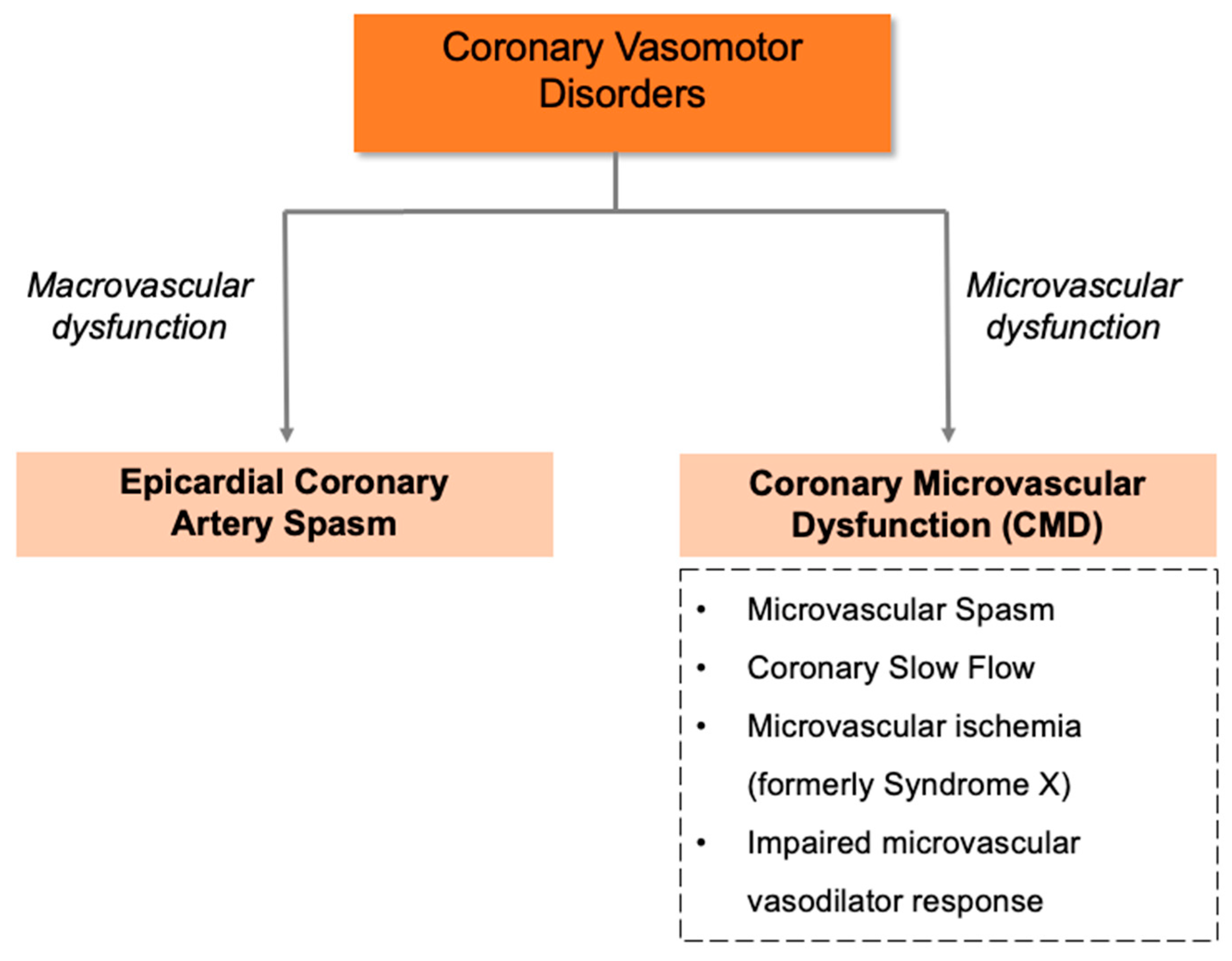
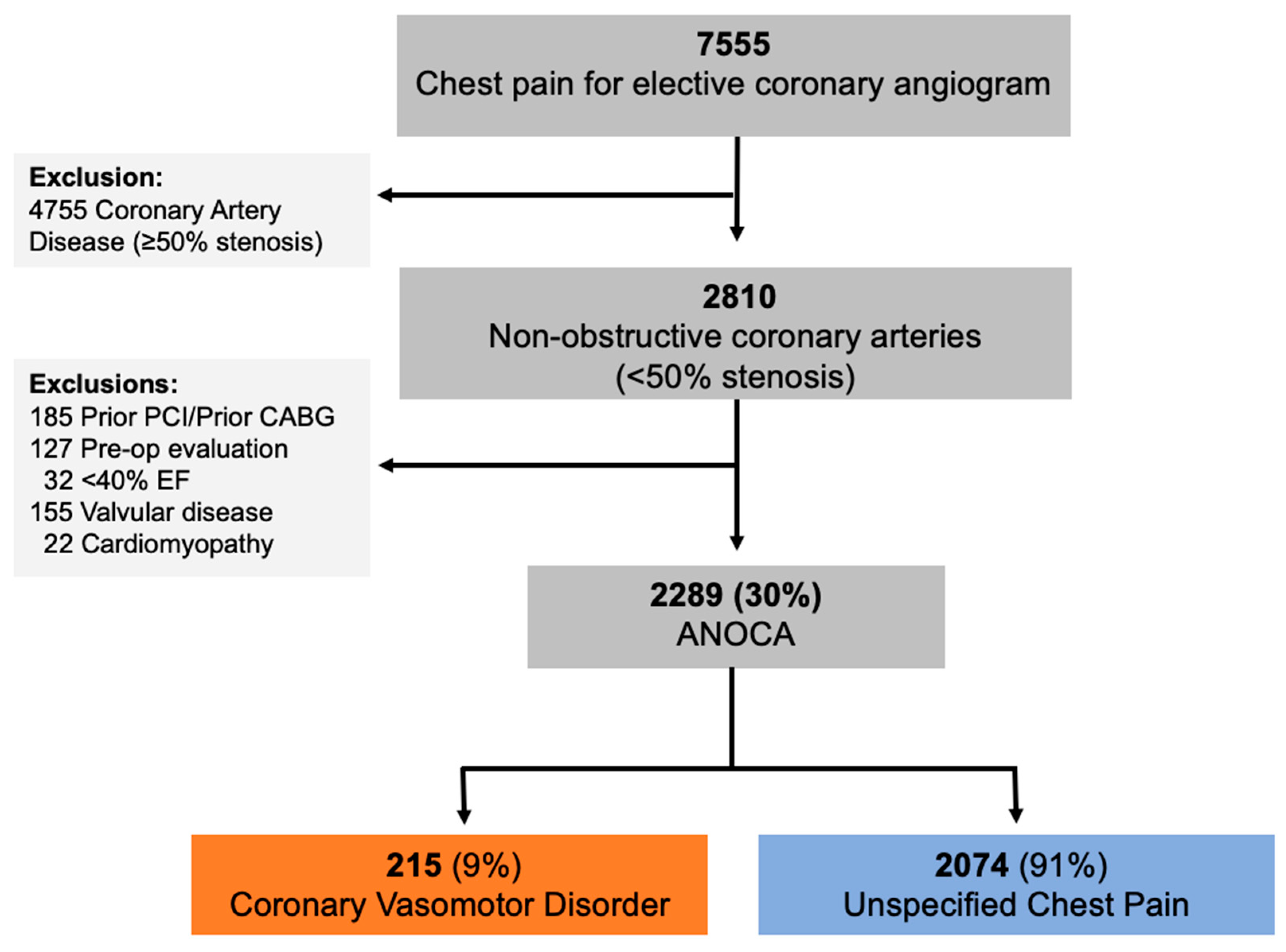
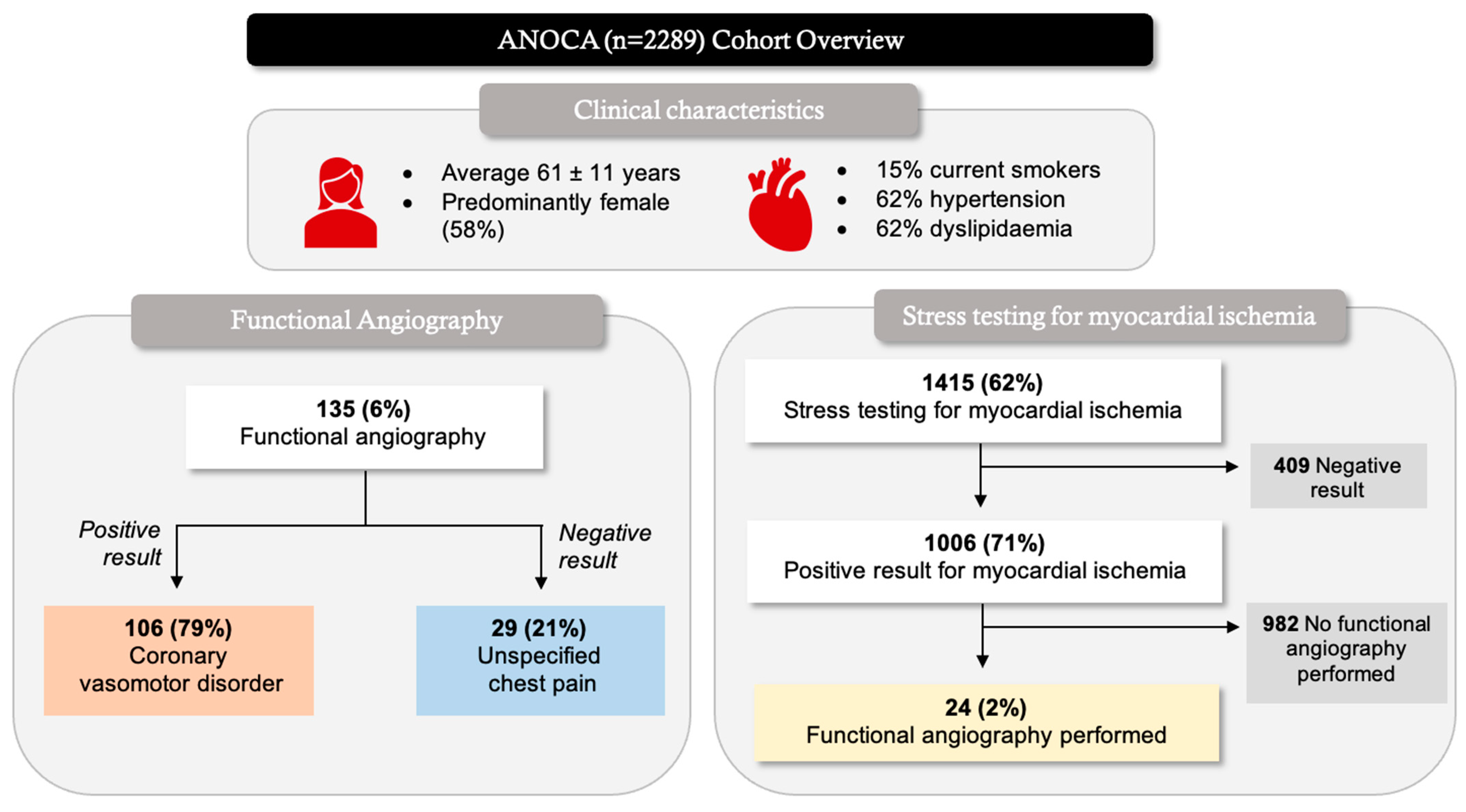
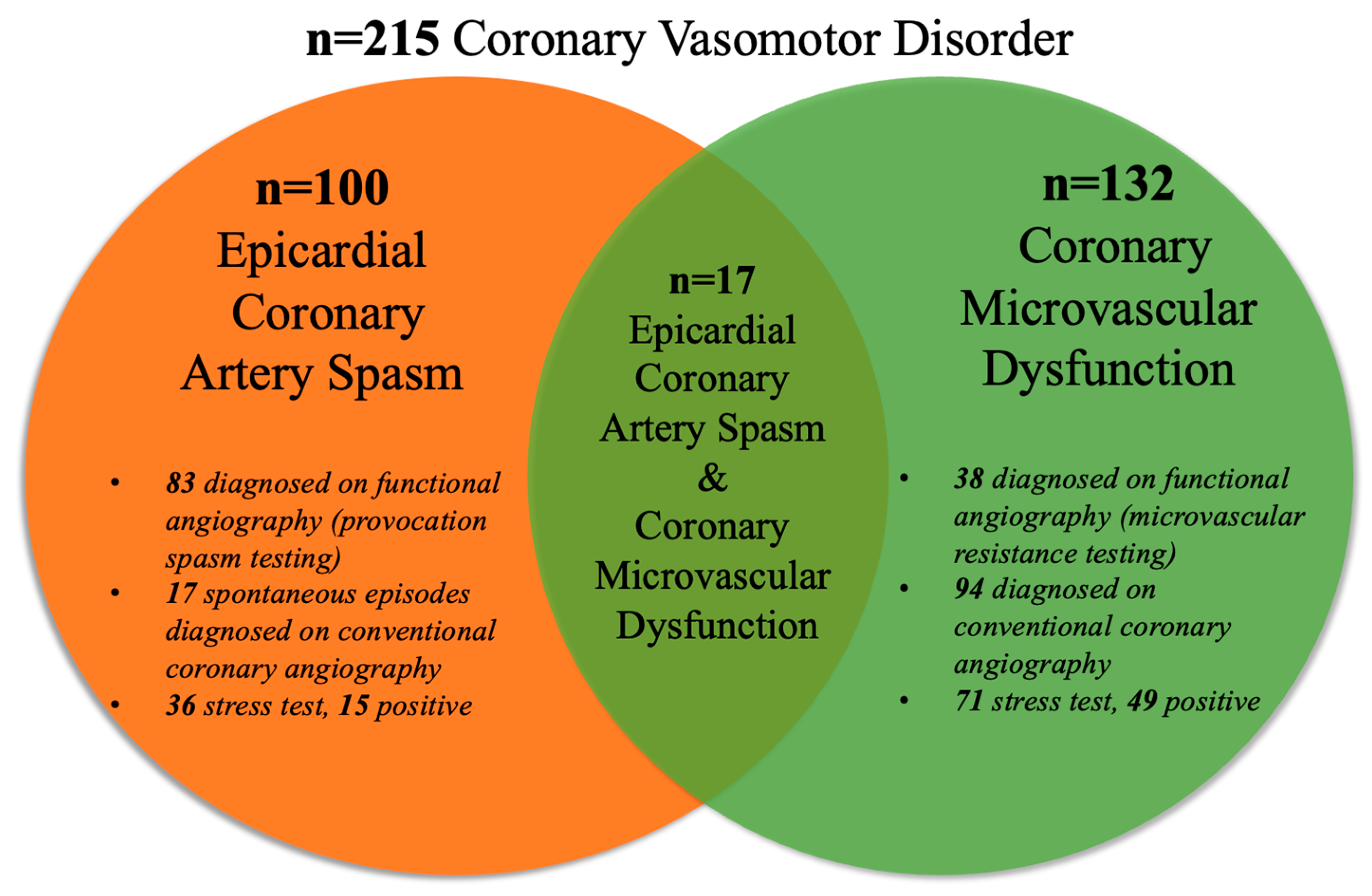
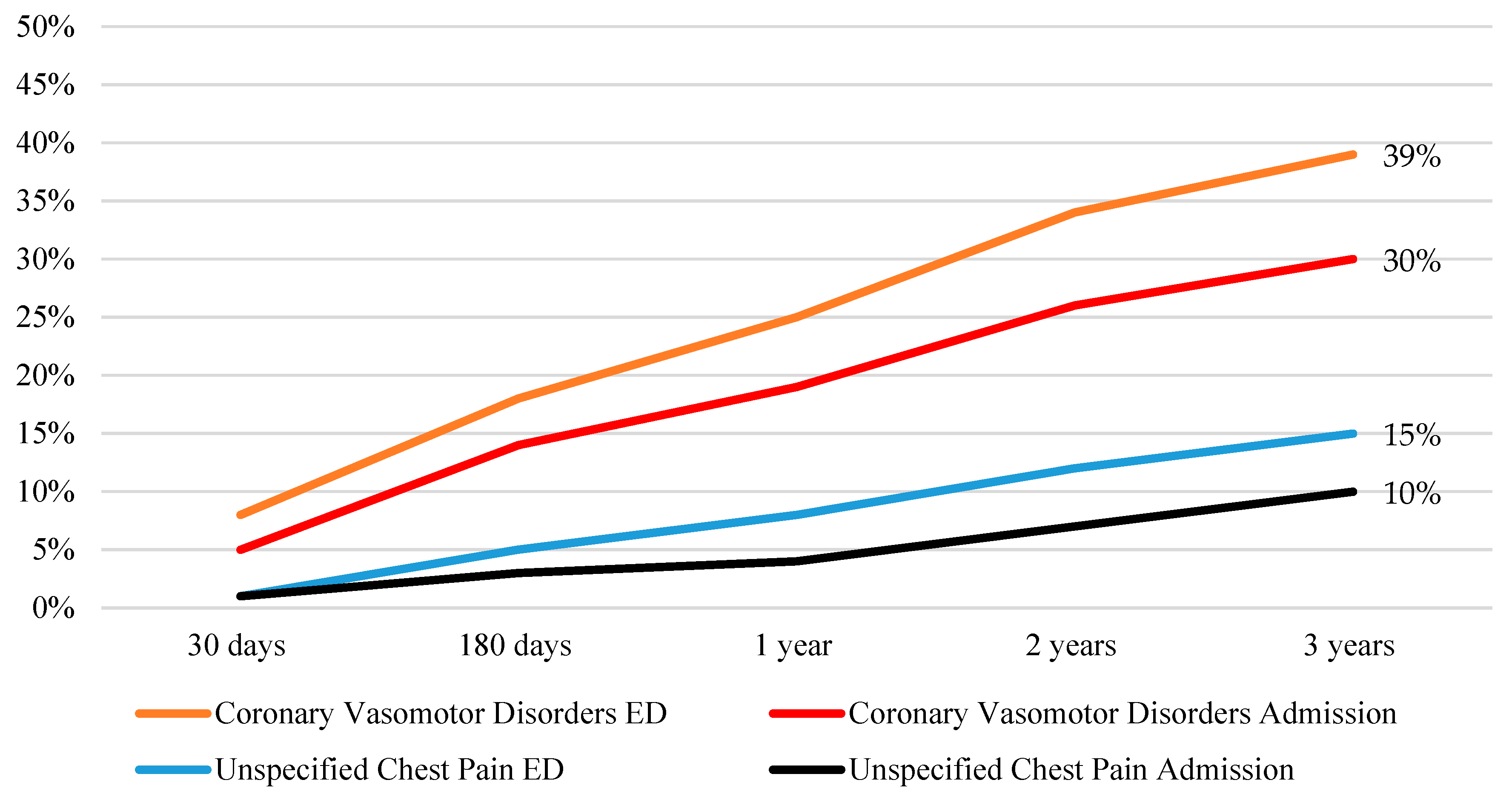
| Diagnosis | ICD 10-AM/ACHI Code |
|---|---|
| Chest pain | R07.3, R07.4, I20.9 |
| Dyspnoea | R06.0 |
| Myocardial infarction | I21.0 to I21.4, I21.9, I22.0, I22.1, I22.8, I22.9 |
| Stroke | G45.9, G46.3, G46.4, I610 to I616, I618, I619, I629 to I636, I638 to I640 |
| Heart failure | I50.0, I50.9 |
| Coronary angiography | 38215-00, 38218-00, 38218-01, 38218-02 |
| Coronary Vasomotor Disorders (n = 215) | Unspecified Chest Pain (n = 2074) | Age-Adjusted p | |||
|---|---|---|---|---|---|
| N | % | N | % | ||
| Baseline characteristics | |||||
| Age (mean ± SD, year) | 215 | 57 ± 11 | 2074 | 61 ± 11 | <0.001 |
| Female | 127 | 61% | 1204 | 58% | 0.214 |
| Current smoker | 32 | 15% | 308 | 15% | 0.341 |
| Hypertension | 110 | 53% | 1311 | 63% | 0.034 |
| Dyslipidemia | 114 | 54% | 1302 | 63% | 0.053 |
| Diabetes | 27 | 13% | 541 | 26% | <0.001 |
| Prior MI | 10 | 5% | 106 | 5% | 0.995 |
| Cerebrovascular disease | 14 | 7% | 135 | 7% | 0.535 |
| PAD | 15 | 7% | 88 | 4% | 0.055 |
| Depression | 70 | 34% | 617 | 30% | 0.583 |
| Asthma | 52 | 25% | 481 | 23% | 0.791 |
| Chronic lung disease | 13 | 6% | 220 | 11% | 0.121 |
| Sleep apnea | 13 | 6% | 103 | 5% | 0.634 |
| New therapies initiated at discharge | |||||
| Anti-platelets | 4 | 2% | 21 | 1% | 0.299 |
| Lipid-lowering therapy | 8 | 4% | 28 | 1% | <0.001 |
| ACE inhibitor | 3 | 1% | 13 | 0.6% | 0.302 |
| ARB | - | - | 8 | 0.4% | - |
| CCB | 43 | 21% | 37 | 2% | <0.001 |
| β blockers | 2 | 1% | 13 | 0.6% | 0.480 |
| Long-acting nitrates | 25 | 12% | 25 | 1% | <0.001 |
| Coronary Vasomotor Disorders (n = 215) | Unspecified Chest Pain (n = 2074) | Age-Adjusted p | |||
|---|---|---|---|---|---|
| N | % | N | % | ||
| All-cause mortality | 1 | 0.5% | 38 | 1.8% | 0.301 |
| Myocardial infarction | 0 | 0% | 6 | 0.3% | - |
| Stroke | 3 | 1.4% | 10 | 0.5% | 0.055 |
| Heart failure | 1 | 0.5% | 25 | 1.2% | 0.447 |
| Repeat angiography | 5 | 2.4% | 53 | 2.6% | 0.976 |
Disclaimer/Publisher’s Note: The statements, opinions and data contained in all publications are solely those of the individual author(s) and contributor(s) and not of MDPI and/or the editor(s). MDPI and/or the editor(s) disclaim responsibility for any injury to people or property resulting from any ideas, methods, instructions or products referred to in the content. |
© 2023 by the authors. Licensee MDPI, Basel, Switzerland. This article is an open access article distributed under the terms and conditions of the Creative Commons Attribution (CC BY) license (https://creativecommons.org/licenses/by/4.0/).
Share and Cite
La, S.; Tavella, R.; Wu, J.; Pasupathy, S.; Zeitz, C.; Worthley, M.; Sinhal, A.; Arstall, M.; Spertus, J.A.; Beltrame, J.F. Angina and Non-Obstructive Coronary Artery (ANOCA) Patients with Coronary Vasomotor Disorders. Life 2023, 13, 2190. https://doi.org/10.3390/life13112190
La S, Tavella R, Wu J, Pasupathy S, Zeitz C, Worthley M, Sinhal A, Arstall M, Spertus JA, Beltrame JF. Angina and Non-Obstructive Coronary Artery (ANOCA) Patients with Coronary Vasomotor Disorders. Life. 2023; 13(11):2190. https://doi.org/10.3390/life13112190
Chicago/Turabian StyleLa, Sarena, Rosanna Tavella, Jing Wu, Sivabaskari Pasupathy, Christopher Zeitz, Matthew Worthley, Ajay Sinhal, Margaret Arstall, John A. Spertus, and John F. Beltrame. 2023. "Angina and Non-Obstructive Coronary Artery (ANOCA) Patients with Coronary Vasomotor Disorders" Life 13, no. 11: 2190. https://doi.org/10.3390/life13112190
APA StyleLa, S., Tavella, R., Wu, J., Pasupathy, S., Zeitz, C., Worthley, M., Sinhal, A., Arstall, M., Spertus, J. A., & Beltrame, J. F. (2023). Angina and Non-Obstructive Coronary Artery (ANOCA) Patients with Coronary Vasomotor Disorders. Life, 13(11), 2190. https://doi.org/10.3390/life13112190






